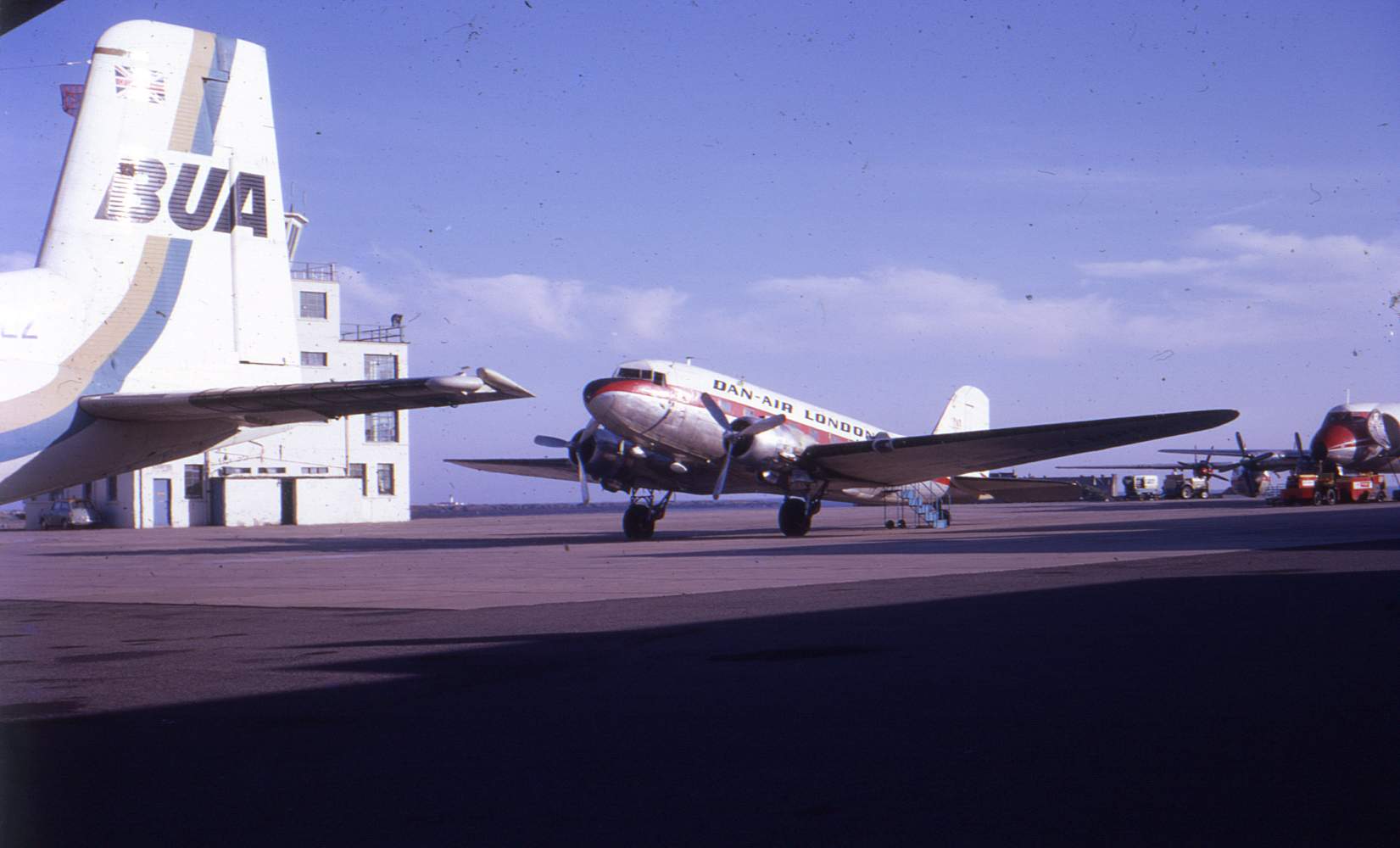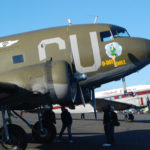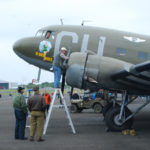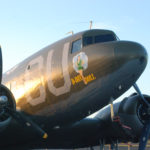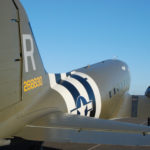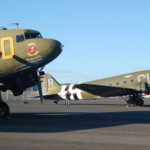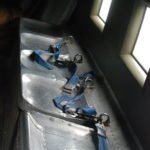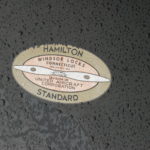D-Day Doll was built at Douglas’s Santa Monica factory as part of a batch of 159 C-53s for the US Army Air Force. C-53s were closer to an airliner specification than C-47s and didn’t have the large cargo door or reinforced floor of the latter. C-53s were also missing the radome and had different instrument and control layouts and a more open layout at the front of the passenger compartment. Named Skytroopers, only 380 were built which makes the Doll and her D-Day squadron sister ‘Spirit of Benovia’ quite select. D-Day Doll also sports Wright Cyclone R-1820 engines rather than the more usual Twin Wasps. After a distinguished war career, D-Day Doll pursued a varied life with multiple owners in South and Central USA before working her way back to her home state of California where she now resides at Riverside Municipal Airport.
D-Day Doll was completed with construction number 11757 on 6th July 1943 and officially delivered to the 434th Troop Carrier Group of the USAAF on 7th July 1943 as 42-68830. She was initially flown from Alliance Field, Nebraska, an airfield which was only opened on 22nd August 1943 and welcomed 434th as one of its first squadrons for training. From there, she moved with 434th to the Baer Army Air Force Base at Fort Wayne, Indiana before commencing her first Atlantic crossing as part of US 9th Air Force to arrive at RAF Fulbeck (Station 488) airfield, Lincolnshire, England in October 1943. Here, the 434th was assigned to the 53rd Troop Carrier Wing and aircraft were allocated to one of four operational squadrons: 71st (fuselage code CJ), 72nd (CU), 73rd (CN) or 74th (ID). Although not named D-Day Doll 830, as part of 72nd squadron commanded by Major Frank W.Hansley, was painted with the code we see on her today: CU. The 434th moved on to RAF Welford Park (Station 474), adjacent to Membury, Wiltshire, on December 19th 1943. From there, the Group moved to RAF Aldermaston (Station 467) ready for the D-Day operation.
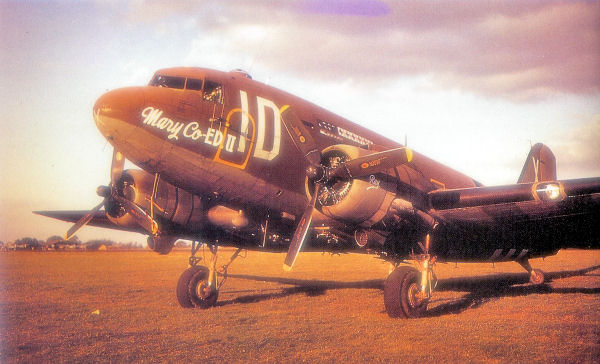
On June 6th 1944 the first of 52 C-47s and C-53s of 434th took off from Aldermaston at around 01:19 destined for Utah Beach. According to to information gathered on the authoritative website 6juin1944.com, D-Day Doll would have been part of Mission Chicago, Serial 27, with 52 aircraft towing Waco CG-4A gliders bound for Landing Zone ‘E’, adjacent to Drop Zone ‘C’, some 5 kilometres inland from Utah Beach and next to the village of Hiesville. The glider fleet had a planned arrival time of 04:00 Z with the initial approach being east-south-east towards the Cotenin Peninsula before turning to run south towards Utah. The 434th glider fleet carried 155 men, including anti tank personnel, 2 anti-aircraft batteries, a bulldozer and a surgical unit. This enabled the establishment of the first surgical unit of the assault at Chateau de Colombiere. One aircraft was lost, C-47 43-15101 piloted by Raymond Howard which crashed into the sea near Isle Marie. As the Dakota fleet turned for home, the gliders below them were experiencing problems. The first release had been on schedule at 03:54 at an altitude of around 450 feet. The Waco gliders then needed to make a 270 degree turn in poorly-illuminated conditions owing to clouds across the moon. Reportedly, only 49 of the original 52 gliders were still operational at release and, of these, only six made it to Landing zone ‘E’. This LZ measured around 1 kilometre by 1.5 kilometre and, although it included some fields larger than the Normandy standard, it also featured high hedges, lines of trees and orchards. Spring dew had moistened the grass and gliders had difficulty stopping before colliding with trees and hedges. Many personnel were killed or injured during the landings with little protection provided by the flimsy Waco CG-4As.
On the evening of June 6th D-Day Doll 830 was in action again with 434th providing 32 aircraft to tow gliders, this time Airspeed Horsas, on Mission Keokuk, Serial 29, arrival time at LZ ‘E’ 21:00. 157 troops of 101st Airborne were transported along with 40 vehicles and 6 guns in the gliders and, this time, no losses are recorded for 434th. The following day a further morning mission, Galveston, Serial 35, was flown by the 434th with 50 aircraft towing CG-4A gliders to Landing Zone ‘W’, close to Les Forges and around 2 kilometres south of Ste Mere-Eglise. Again, no losses are recorded for 434th but the total number of C-47s lost by USAAF on June 6th and 7th amounted to 42.

As the allied armies fought their way out of Normandy and pushed north-east, the aircraft of 434th continued to fly from Aldermaston on a gruelling programme of re-supply and evacuation missions. By September, the allied armies thought they were sufficiently advanced to attempt to seize 9 bridges in Holland which would enable them to push rapidly into Northern Germany. A succession of plans were formulated and rejected until Market Garden was proposed. US, British, Polish and Canadian ground and airborne troops would combine in the operation. 434th aircraft were to transport paratroops of 101st Airborne again and subsequently tow gliders and provide logistics support. Virtually no training had taken place for the operation which was scheduled for September 17th. The phase of the moon meant that there would be very little lunar illumination, so the operation was planned for daylight with the 101st Airborne allocated four drop zones and one landing zone in the Eindhoven region. Sunday 17th September dawned fine with predicted early fog and light winds. Serial A-4 comprised 71 squadron and 72 squadron which included 42-68830, D-Day Doll. The 45 aircraft in Serial A-4 carried paratroops and were bound for DZ ‘A1’ near Veghel. Unfortunately, the pathfinder aircraft dedicated to A1 had been shot down over Belgium and, with no homing device, the 1st battalion were dropped around 5 miles short of Veghel at 13:01. The other 434th squadrons from Aldermaston, 73 and 74, Serial A-6, fared better and delivered their 101 Airborne 501st paras and 326th Airborne Engineers to Dropzone ‘A’ at Erde at 13:06. The two groups together captured their targeted two rail bridges and two road bridges at Veghel. The daylight operations had contributed to the loss of four aircraft from Serial A-4 and one from A-6.
American forces allocated to Drop Zones B and C had more mixed fortunes with the 502nd paras dropped at ‘B’ capturing the bridges at Sint-Oedenrode but failing to take the Wilhemina Canal bridge at Best before it was blown-up by the Germans. The 506th dropped at DZ ‘C’ captured none of the bridges on the first day but did take all four Eindhoven bridges on 18th. The Wilhemina Canal Bridge at Son, however, was also blown by the Germans and the enemy forces were proving more resilient than expected. Against this background, the reinforcements delivered by D-Day Doll and her compatriots on 18th would have been very welcome. The Aldermaston squadrons supplied 40 aircraft for Serial A-35, Squadrons 72 and 74, and 40 for Serial A-47, Squadrons 71 and 73. Both were towing Waco gliders filled with troops from the 327th Glider Infantry Regiment and both were heading to Landing Zone ‘W’ close to Son where the crossing of the bridge was essential to push reinforcements to the British forces to the north at Arnhem. The two 434th missions were very successful with no losses on Serial A-47’s 15:24 arrival slot and two losses on Serial A-35. The daylight operation meant that 80%+ of gliders were arriving within a kilometre of their target.
By September 19th, the weather was deteriorating but 434th flew two further operations each comprising 40 aircraft towing gliders: A-72 arrived at Landing Zone ‘W’ at Son at 14:37, A-78 at 15:45. No 434th aircraft were lost.
On September 20th, 434th was in action with 53 aircraft dropping supplies to 82nd Airborne at Drop Zone ‘O’ to the south of Nijmegen at 16:48. The final contribution to Market Garden by D-Day Doll’s Troop Carrier Group was on 25th September when 16 aircraft delivered supplies to 101st at Eindhoven Drop Zone ‘W’ at 16:38.
Following Market Garden, D-Day Doll’s Squadron and the rest of 434th reverted to logistics missions and evacuation flights. The US forces aimed to return wounded soldiers who were able to travel to the USA and C-47/ C-53 evacuation flights were often directed to Prestwick where the wounded personnel were transferred to C-54s for the transatlantic flight. As with the RAF Dakota squadrons ( for example 233, 512 and 271 squadrons), the 434th aircraft remained based in the UK but flew missions from Aldermaston to forward airstrips established on the continent. Between D-Day and Market Garden, the US 9th Engineers had built 86 forward airstrips, the Royal Engineers 76 and these fed food, fuel and ammunition to the rapidly-advancing British, American and Canadian forces. 101st Airborne had moved to one of these bases, Mourmelon-le-Grand near Reims, where they had constructed a 6000′ Pierced Steel Planking runway.
Post-Market Garden the allies concentrated on pushing Axis forces back to the Rhine prior to Montgomery’s planned Rhine Crossing. One of Market Garden’s main aims had been to secure the port of Antwerp in order to feed reinforcements into the Netherlands. Equally, the German’s surprise counter-offensive in late 1944 was designed to split allied forces and re-take Antwerp. Taking advantage of bad weather, Nazi tank forces swept through the Ardennes towards the hub town of Bastogne. The ‘Bulge’ in the Axis forward offensive line gave this, the largest German battle on the western front, its name. Eisenhower managed to reinforce Bastogne with 101st Airborne just in time to halt the German advance but the price was that Bastogne was besieged by the enemy with poor weather precluding re-supply operations. The offensive had started on December 16th and, by 19th, 101st Airborne had been rushed to the town from Mourmelon-le-Grand. By 21st December Bastogne was surrounded and there was no sign of the fog lifting. On December 23rd UK-based C-47s carrying Pathfinders managed to drop two teams on the periphery of Bastogne and they set-up Eureka beacons to guide in further C-47s with ammunition and supplies. A slight improvement in the weather enabled 16 C-47s to deliver supplies on 23rd and, by dusk, 241 aircraft had dropped 440 tons of essentials. Another 160 aircraft (from 441st TCG) dropped 100 tons the following day and there were further drops on 26th and 27th December. D-Day Doll’s 434th TCG definitely took part on 26th while 439th and 440th flew from Orleans on 27th. Patton’s Third Army reached Bastogne on 26th and the siege was lifted, but the fighting continued into the New Year and left huge numbers of both American and German casualties.
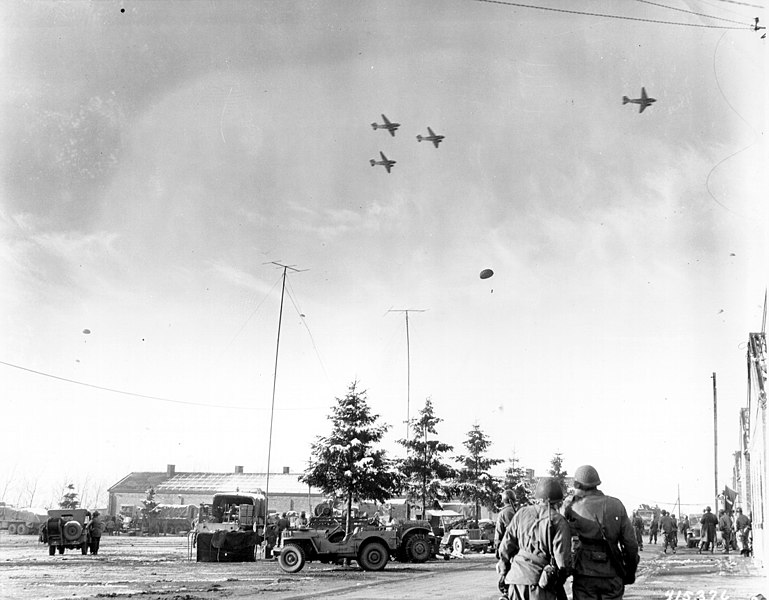
D-Day Doll also took part in the main Rhine Crossing operation on 24th March 1945. By then, 434th had moved from the relative comfort of Aldermaston to 101st’s forward air strip at Mourmelon-le-Grand during mid-February 1945. Following consolidation on the west bank of the Rhine and the repulse of the Ardennes Offensive, the allies were due to invade Germany for the first time. In fact Patton’s 3rd Army had already crossed the Rhine further south at Oppenheim, near Mainz, on March 22nd and again near Worms the following day. Even before that, the Ludendorff Bridge at Remagen had been captured on March 7th and Sgt Alexander Drabik had become the first occupying soldier to cross the Rhine.
For the main operation, the British 2nd Army, the Canadian 1st Army and the 9th US army would cross the Rhine in ‘Operation Plunder’, the largest-scale river crossing ever. A huge airborne flotilla of aircraft would tow gliders to unsecured landing zones without the previous landing of paratroops. Major Gordon, 454th TCG’s Glider Operations Officer described an airborne carpet which took 2 hours and 18 minutes to pass overhead; varying figures quote 42 C-53s like D-Day Doll along with 226 C-47s and 72 C-46s carrying paratroops and 610 C-47s towing 906 gliders (some aircraft were double-towing two gliders). A further 752 Dakotas and 420 gliders carried the British 6th Airborne. Aircraft of 434th were dedicated to Landing Zones ‘X’ and ‘W’. The landings weren’t without problems but, Operation Varsity, the airborne part of the crossing, was the last and biggest single-day airborne operation of the war. The allies were on their way to Berlin and the final capitulation of Nazi Germany on 8th May 1945.
Following the German surrender, 434th flew fuel and supplies into allied forward bases and wounded soldiers back to the UK. Some prisoners of war were moved to camps in France and Holland by air too. However, demobilisation was not long in coming and 434th departed Mourmelon-le-Grand in July 1945 en route home to the USA. They reversed their earlier mobilisation, probably via Prestwick, to arrive Baer Field on 4th August 1945 and Alliance on 15th September. Upon arrival at Alliance, D-Day Doll’s 72 Squadron Commander had been promoted and, as Lt.Colonel Frank W.Hansley, became Commander of 434th. However, by then, D-Day Doll, 42-68830, had been transferred via the Robins AFB to the Reconstruction Finance Corporation on 6th August for disposal at the end of her military career.
References:
The D-Day Squadron site provided the inspiration, JMG Gradidges Air Britain book ‘The Douglas DC-3 and its Predecessors’ the framework and the following books military detail:
‘The Longest Day’ and ‘A Bridge Too Far’ , both by Cornelius Ryan
‘Arnhem 1944’ by Martin Middlebrook, ‘Second World War’ by Martin Gilbert, ‘The Struggle for Europe’ by Chester Wilmot, ‘The Times Atlas of the Second World War’, ‘USAAF Continental Airfields D-Day to VE Day’ by 1st Lt. D.C.Johnson USAF and Richard Killblane’s article on the Bastogne Pathfinders in WorldwarII magazine.
Many websites provided information with the following particularly useful: www.6juin1944.com, www.airbornetroopcarrier.com, www.ww2gp.org, www.ww2days.com, www.ww2db.com, www.ww2marketgarden.secondworldwar.nl, www.historyofwar.org for J.Rickard’s article on 434th TCG.
42-68830 was demobilised to an unknown civil owner, quite possibly a conversion company like Canadair. Registered N45366, she began her career as an airliner on lease to Penn Central Airlines as from 20th November 1945*. Although originally based at Pittsburg, PCA had moved to the new Washington National Airport at Arlington in 1941 and promoted their connection with the capital. By 1947 Penn Central operated around 25 DC-3s and N45366 was given the fleet number 230C and the name ‘Hendersonville’. This was changed to ‘Capitaliner Toledo’ following PCA’s name change to Capital Airlines on 21st April 1948. The Company’s shaky financial status was improved by restructuring and the previously-leased N45366 was bought by the airline on 1st August 1949.
By 1955, Capital were operating Vickers Viscounts and the turbo prop airliners gradually replaced the older piston-powered fleet. Although Capital would become one of the last major US operators of the DC-3, fleet disposals led to the sale of the D-Day Doll to the Crucible Steel Company of America on February 16th 1959.
*20th Nov 1945 is the date given on the plate detailing her conversion to a DC-3 for ‘The Capital Airline’.
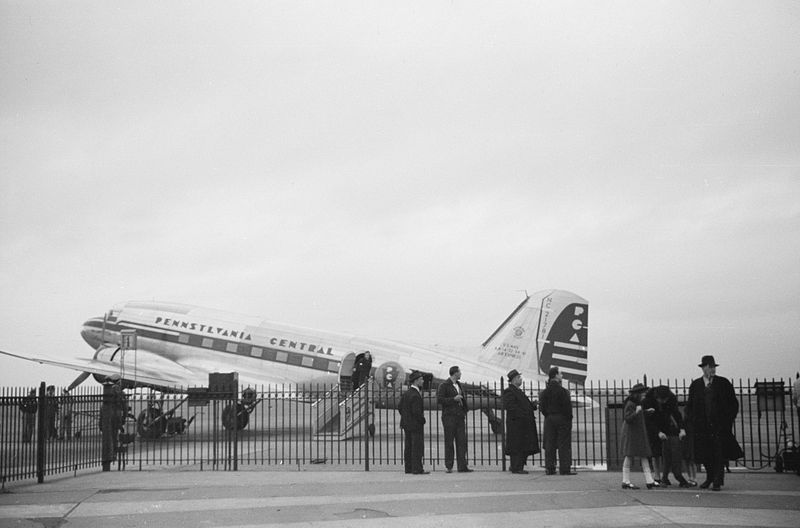
The next change of ownership recorded is to Walston Aviation of Illinois who, it seems likely, are the Cessna dealers based at St.Louis Regional Airport. It is possible that the transaction represented a trade-in. By 1965, N45366 had moved south and was registered to Palm Beach Yacht Sales in Florida. This may also have been during a sales transaction as, by later in 1965, she was registered to the De Soto Air Park, a small air enterprise on the border of Tennessee and Mississippi. The airfield had a short 2600′ paved runway and was home to quite a large flying school and maintenance facility formed by Charlie Pennington and Walt Looney. Although N45366 was quite a large aircraft to occupy the site, Charlie Pennington was reputed to be very adept at short-field landings. The company diversified into ad hoc charter work and painted the DC-3 with Pen-Lo Air Inc titles, a name derived from the first letters of their respective surnames. Although issued with an FAA commercial operators certificate, the Mississippi registered organisation ran foul of operating restrictions on parcel flights. N45366 was registered to Penlo Air Inc of Memphis, Tennessee in 1966 which was perhaps a reflection of the company moving charter operations from De Soto to Memphis Metropolitan Airport across the state line. Two more ownership changes were recorded in 1969 with D-Day Doll recorded as going to Texas Aircraft Leasing in Dallas in August and, later, back to Penlo Inc in Memphis. On December 31st 1968 four DC-3s were recorded as being operated by Penlo Air Inc and, certainly, both N977W and N143A also wore the smart white, blue and grey Penlo colour scheme. In May 1970 Walt Looney sold his interest in De Soto airfield and Penlo operations may have ceased the following year. At least one DC-3 remained at De Soto in 1971. N45366 was sold to Jim Hankins Air Service at Jackson, Mississippi, in 1971, a company which operated a similar level of service to Penlo.
Jim Hankins Air Service had been started in 1958 and, during the 1960’s, operated Beech 18s from Jackson, Mississippi. During the 1970s several DC-3s came and went with both D-Day Doll and N88874, ‘Thats All Brother’ serving during 1971-72. Mail routes and cargo charters were flown between Jackson and airports in Alabama, Tennessee, Vermont and New York. Amazingly, the airline was only wound-up in 2017 although, by then, its remaining DC-3s had been parked-up for some time. Aircraft which had been operated included N91314, N842MB, N8061A, N3BA, N15M and N447RS.
C-53 D-Day Doll, however, wasn’t there long before moving to Bay Airways in 1972. The new operator appears to have been a (very) short-lived Third Level operator in Cambridge, Maryland. By 1973, N45366 was registered to Florida World Inc. of Fort Lauderdale and was flying with Florida’s Shawnee Airlines of Orlando by the following year. Routes were flown chiefly between Orlando, Fort Lauderdale, West Palm Beach and the Bahamas with their fleet of DC-3s and Martin 404s painted in garish yellow and pink ‘tropical’ colours. The airline was purchased by Florida Airlines in 1975 and, subsequently, by Air Miami in 1978. By the later date, the majority of the DC-3s had been withdrawn and were parked at Florida Airlines Sarasota maintenance base. N45366 had been sold to Transexecutive Aviation of Pittsburgh on August 11th 1977 but remained at Sarasota until September 1980. She was then purchased by E.Stern and, on 13th August 1982, by Howard Hefley of Kansas City on behalf of Harvest Fields Missionary Association to whom she was leased.
The Harvest Fields Missionary Association commenced their lease of N45366 on 13th August 1982 and seem to have operated the aircraft until 1985 when her sale is recorded to E-Systems Inc. This is an interesting company with a long history of converting aircraft for the US military and CIA. Their work included equipping and maintaining AC-47 gunships, surveillance of cross-border drug shipments and electronic imaging. There have also been allegations that they applied redundant US registrations to aircraft in their care – so it is possible that the registration rather than the aircraft was attributable to the company. The company, which took over Air America’s Air Asia operation and is now part of Raytheon, denies any illegal activity. Either way, N45366 was advertised for sale in Trade-A-Plane in September 1986 and, on 28th January 1987, was sold to Daniel R.Kitley of Acampo, Sacramento in California. Dan Kitley was an aviation mechanic who owned Kitley Aviation. The C-53 was now finished in a natural metal and royal blue colour scheme and appears to have operated from both Kitley’s local airfield at Lodi and from Yolo County Airport to the west of Sacramento. She was used for parachute operations. N45366 was photographed at Lodi in May 1993 wearing ‘Douglas DC-3’ titles and also appears there in an April 1997 picture in Kengo Yamamoto’s book, Douglas DC-3:The Survivors. Some sources say that she was transferred to a company called DC-3 Flights Inc of Stateline, Nevada and Kengo Yamamoto quotes them as being the owners. It is possible this was an administrative move as the aircraft continued to operate from Yolo and Lodi and this would explain the ‘Douglas DC-3’ titles*. By September 2001 she was parked-up in storage at Richmond, Virginia. On 4th December 2001 N45366 was transferred to the American Airpower Heritage Flying Museum of Midland, Texas. Her restoration as D-Day Doll was to be managed by the Commemorative Air Force’s Inland Empire Wing, the public face of the Heritage Flying Museum, and, to this purpose, she was returned to flying condition for a ferry flight to Riverside, California.
It took a year to return the Doll to full flying condition with, reportedly, 80 personnel working on the project and an investment north of $60,000. The initial paint scheme chosen featured her USAAF serial 268830 but used identity letters ‘M2’ rather than the 72nd Squadron’s ‘CU’ in honour of Bob Hope’s aircraft used on USO tours. With her nose art as D-Day Doll (there is, in fact, no record of her actual name at D-Day), appearances were made all over the west of the USA.
On a flight to the 13th ‘Wings, Wheels and Rotors’ show at Los Alamitos Army Air Base in 2014, a valve shattered leading to an engine shut-down three minutes after take-off from their Riverside base. Pilots Richard Hammerschlag and Gevin Harrison managed to land the aircraft safely back at Riverside but she was out of action for almost a year while a new engine was sourced and fitted.
In Spring 2019 she was resprayed in new olive colours and the ‘CU’ letters were proudly painted next to the D-Day Doll artwork ready for her departure to Europe, a flight which would take 3 months and encompass 13,000 miles and accommodate 126 parachutists on 8 drops in Normandy.
* Alternative sources give the date of sale to DC-3 Flights as 15th July 1998, 15 months after Kengo Yamamoto’s picture.
Parallel Lines: When researching N45366’s history, the life story of another C-53 appeared to run in parallel for many years following sale by the Reconstruction Finance Corporation. Construction number 11778, the last of the batch of 159 C-53s, was delivered as 42-68851 and served with the USAAF in North Africa before being demobilised by the RFC. Like D-Day Doll, she passed from Penn Central on to Capital Airlines and, in 1961, to United Airlines following their take over of the ailing Capital. After a spell with the Beldex Corporation, still with the registration N45338, she also passed to Penlo Air Inc in Missouri in May 1967. Still in parallel with D-Day Doll she was registered to Jim Hankins Air Service in Jackson from March 1971 to 1972. She is then recorded as moving to C&C Aero Systems of Van Nuys, California, before also joining Shawnee’s fleet in Florida for four years until recorded as being sold (along with N45366) in 1977 to Transexecutive Aviation in Pittsburgh. N45338 was sold to Aero Virgin Islands Corporation on 24th July 1978 and worked with them until the early eighties. Malcolm Nason’s photograph on the Air Britain website shows a natural metal N45338 stored wingless and engineless at Fort Lauderdale, Florida in June 1981. It was reputedly due to be rebuilt with the wings and rudder of the damaged DC-3 N9025R but I don’t know how far this went. Also, the similarity of career with D-Day Doll seems to be more than coincidence: maybe they were both owned by the same finance house or leasing company?
D-Day Doll D-Day Squadron Travel
N45366 flew from Chino, California, to her home base of Riverside on 5th May 2019. From here, she departed for Tucson, Arizona on 8th May as she gradually worked her way across-country to Oxford Connecticut. Amarillo, Texas, was visited on 9th May, en route to Kansas City, Missouri, the same day. The America’s oldest airport, Bowman Field at Louisville, Kentucky, used for glider training in WW2, was visited on 10th May and Grimes Field, Urbana, Ohio on 12th May. Poor weather in Ohio precluded a planned parachute jump but D-Day Doll flew the 30 minute hop to Columbus, Ohio, on 13th with 99-year old 1st Lt. Alfred Pepper on board. The veteran was no stranger to Dakotas, having flown C-47s over ‘The Hump’ between China and Burma during WW2. From Colombus, D-Day Doll flew to Oxford, Connecticut (KOXC) on 14th May, ready for the D-Day squadron kick-off meeting. During the next four days, training and briefings took place along with formation flying practice during ceremonial flypasts of the Statue of Liberty and the Pratt & Whitney plant at Hartford, Connecticut. The latter took place on May 16th while the formation flight south along the Hudson River to New York was on May 18th. The following day, the main group of D-Day squadron aircraft departed Oxford en route to Presque Isle, Maine on the first leg of the transatlantic crossing.
From the beginning the weather was not brilliant with rain helping to locate a good number of leaks in the D-Day Doll. There was a good turn-out at Presque Isle before the squadron headed on to Goose Bay, Canada, also on May 19th. Here the weather conditions were bad and the Doll remained snowed-in until May 22nd when she headed for Narsarsuaq in loose company with Flabob Express and Pan Am N877MG. The spartan interior of D-Day Doll doesn’t benefit from much in the way of heating and the northern sections of the ‘Blue Spruce Route’ proved to be cold at 10,000 feet. The following day, May 23rd, D-Day Doll flew on to Reykjavik before the longest over sea leg to Prestwick the following day. Following winds pushed D-Day Doll along at a sprightly 200 kts and she touched down at Prestwick at 15:35 on May 24th. The eight D-Day Squadron aircraft were displayed for a photographic evening on May 24th and at a rather damp open day on Saturday May 25th.
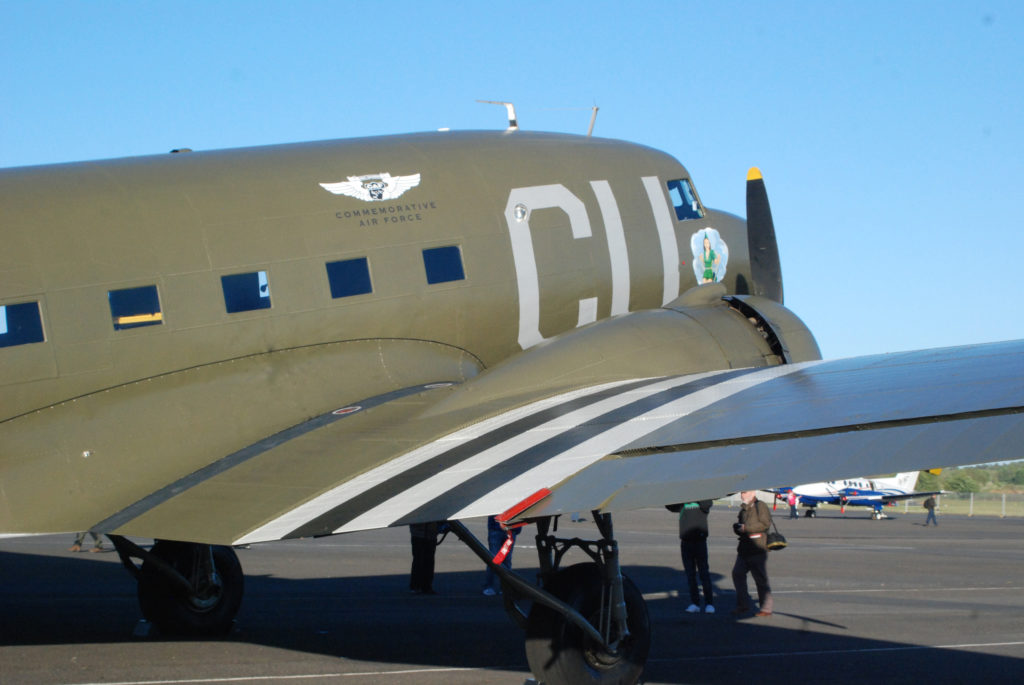
D-Day Doll departed Prestwick on Monday May 27th in company with five C-47s en route to Duxford. The Doll took off at 13:05, just after Flabob Express and Virginia Ann and arrived at Duxford in just under 2 hours at 14:59, her transatlantic crossing complete.
By June 1st, D-Day Doll was one of nine Dakotas which remained at Duxford while a further seven flew to the Shuttleworth Trust at Old Warden. D-Day Doll flew an individual mission on June 2nd when she performed a solo flypast of the old Pathfinder airfield at North Witham between Stamford and Grantham, just off the A1. C-47s from this airfield flew Pathfinder missions for D-Day, Market Garden and also the Siege of Bastogne. On the ground was 97-year old Dave Hamilton, a veteran of the June 5th Pathfinder operation on D-Day (-1!) and now a resident of Prescott, Arizona. He was later to join the crew of D-Day Doll at a celebration dinner back in California following their return home.
All the Dakotas were re-grouped at Duxford by June 3rd and an evening photo shoot was held. the following day, June 4th, was the first of the two display days with D-Day Doll taking part in formation flights over the East Anglian countryside with up to 14 Dakotas. Four missions were undertaken on June 4th and, the next morning, D-Day Doll departed for Cherbourg with four other Dakotas to pick-up 18 British paratroops for a drop over Carentan to commemorate the work of the Pathfinders. Following the drop, D-Day Doll returned to Duxford ready for the big formation flight to Normandy that afternoon. The take-off was slightly delayed but, with paratroops on board, D-Day Doll departed for the formation flight to Normandy via Colchester and the South Coast.
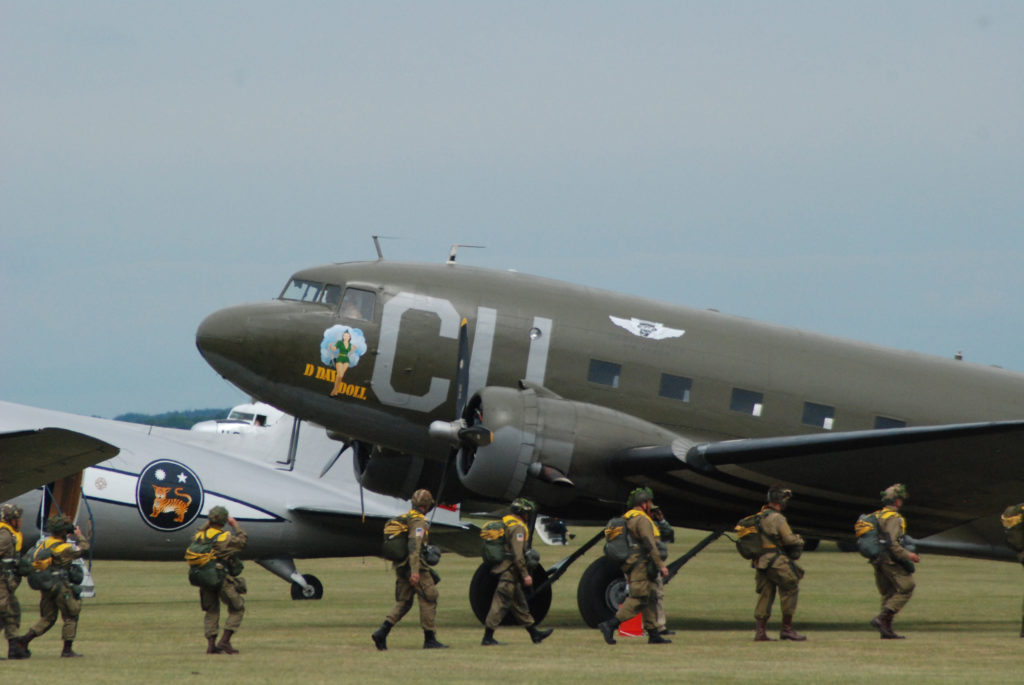
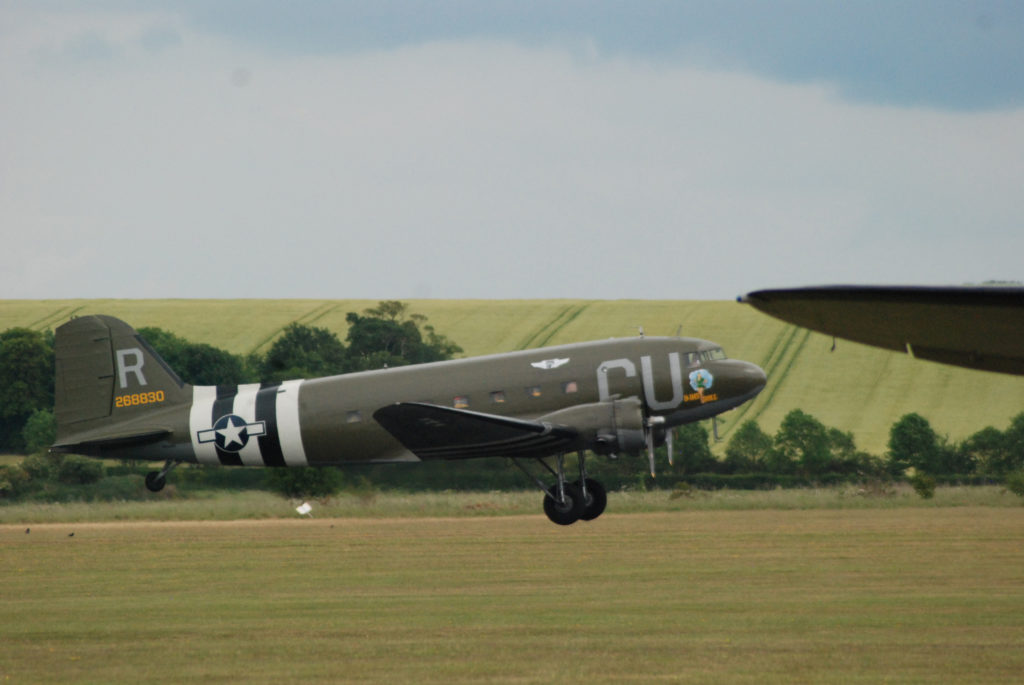
On the June 6th anniversary, D-Day Doll was scheduled to overfly the American Cemetery at Colleville-sur-Mer in formation but the event was delayed by the movements of the US President and Air Force One. The formation flew passes over Pointe du Hoc and Pegasus Bridge before returning to Colleville. By June 9th, D-Day Doll had made 7 flights enabling 126 parachutists to make commemorative jumps at Carentan, Sannerville, Ecausseville, La Fiere and Lessay. On the evening of June 9th she departed for Wiesbaden following the last jump at La Fiere. In company with Placid Lassie, D-Day Doll carried-out a flypast of Bastogne while en route to Germany. After a great reception at Wiesbaden, D-Day Doll left on June 12th in the company with fellow CAF C-47 ‘That’s All Brother’ on a scheduled flight to Fasberg ready for Berlin Airlift commemorations. Bad weather intervened and the two CAF aircraft diverted to Nordholz Naval Air Base on the Baltic coast. The crew were billeted at Bremerhaven barracks before heading to Fasberg on June 13th. The Berlin flypast was accomplished on June 16th but the aircraft were not permitted to land or drop the ‘candy parachutes’ and, instead, flew to Schoenhagen. Leaving Germany, the Doll arrived at Le Bourget for the Paris Air Show on June 19th. The airshow took place between June 21st and 23rd with D-Day Doll flying on June 22nd. The long flight home commenced on June 24th with bad weather leading to a diversion from the planned stop at Coventry to nearby Birmingham International Airport. D-Day Doll took off in heavy rain the following morning, setting course for Prestwick, Scotland and on to Reykjavik. June 26th saw D-Day Doll en route from Iceland to Greenland with a weather divert to Nuuk, 400 km to the north-west of Narsarsuaq. On 28th June, D-Day Doll arrived at Goose Bay, just behind Placid Lassie and ahead of Virginia Ann and That’s All Brother. On 29th June the aircraft reached Presque Isle before pushing on to Albany ready for the Million Air display. The next appointment on the way home was the Oshkosh fly-in on July 27th and 28th in the company of 9 other D-Day squadron aircraft. D-Day Doll arrived there with plenty of maintenance time. At the end of the gathering, D-Day Doll departed for visits to Omaha, Nebraska on July 29th and Albuquerque, New Mexico on August 3rd. She arrived home at Riverside Municipal Airport on August 5th at 12:05 to a suitably enthusiastic welcome. Great thanks are due to pilots Steve Rose, David Brothers, Tim Tarris, the mechanics, ground crew, logistics team and all those at the CAF who brought D-Day Doll to Europe for the Normandy landings and Berlin Airlift commemoration.
Hits: 1385
